
A bogie is a chassis or framework that carries a wheelset, attached to a vehicle—a modular subassembly of wheels and axles. Bogies take various forms in various modes of transport. A bogie may remain normally attached or be quickly detachable ; it may contain a suspension within it, or be solid and in turn be suspended ; it may be mounted on a swivel, as traditionally on a railway carriage or locomotive, additionally jointed and sprung, or held in place by other means.

A narrow-gauge railway is a railway with a track gauge narrower than standard 1,435 mm. Most narrow-gauge railways are between 600 mm and 1,067 mm.
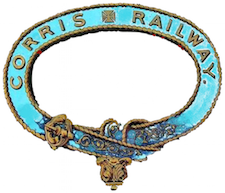
The Corris Railway is a narrow gauge preserved railway based in Corris on the border between Merionethshire and Montgomeryshire in Mid-Wales.

A railcar is a self-propelled railway vehicle designed to transport passengers. The term "railcar" is usually used in reference to a train consisting of a single coach, with a driver's cab at one or both ends. Some railway companies, such as the Great Western, termed such vehicles "railmotors".

The Snowdon Mountain Railway is a narrow gauge rack and pinion mountain railway in Gwynedd, north-west Wales. It is a tourist railway that travels for 4.7 miles (7.6 km) from Llanberis to the summit of Snowdon, the highest peak in Wales.

A third rail, also known as a live rail, electric rail or conductor rail, is a method of providing electric power to a railway locomotive or train, through a semi-continuous rigid conductor placed alongside or between the rails of a railway track. It is used typically in a mass transit or rapid transit system, which has alignments in its own corridors, fully or almost fully segregated from the outside environment. Third rail systems are usually supplied from direct current electricity.

A tank locomotive or tank engine is a steam locomotive that carries its water in one or more on-board water tanks, instead of a more traditional tender. Most tank engines also have bunkers to hold fuel; in a tender-tank locomotive a tender holds some or all of the fuel, and may hold some water also.
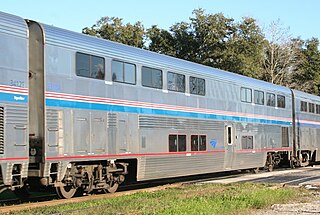
A passenger railroad car or passenger car, also called a passenger carriage, passenger coach, or passenger bogie (India) is a railroad car that is designed to carry passengers. The term passenger car can also be associated with a sleeping car, a baggage car, a dining car, railway post office and prisoner transport cars.

A horsecar, horse-drawn tram, horse-drawn streetcar (U.S.), or horse-drawn railway (historical), is an animal-powered tram or streetcar.
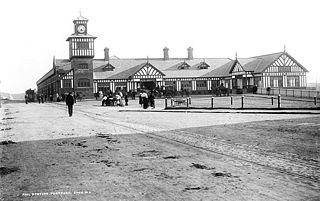
The Giant's Causeway Tramway, operated by the Giant's Causeway, Portrush and Bush Valley Railway & Tramway Company Ltd, was a pioneering 3 ft narrow gauge electric railway operating between Portrush and the Giant's Causeway on the coast of County Antrim, Northern Ireland. The line, 9+1⁄4 miles (14.9 km) long, was hailed at its opening as "the first long electric tramway in the world". The Giant's Causeway and Bushmills Railway today operates diesel and steam tourist trains over part of the Tramway's former course.

Crewe Heritage Centre is a railway museum located in Crewe, England. Managed by the Crewe Heritage Trust, the museum is located between Crewe railway station and Crewe town centre; the site was the location of the 'Old Works' which was demolished in the early 1980s.

The Penrhyn Quarry Railway was a narrow gauge railway in Caernarfonshire, Wales. It served the Penrhyn quarry near Bethesda, taking their slate produce to Port Penrhyn, near Bangor. The railway was around six miles (9.7 km) long and used a gauge of 1 ft 10+3⁄4 in.
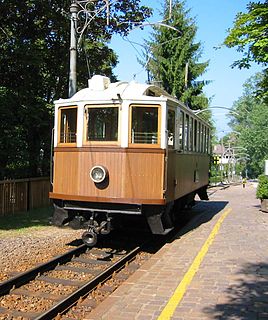
A bow collector is one of the three main devices used on tramcars to transfer electric current from the wires above to the tram below. While once very common in continental Europe, it was replaced by the pantograph or the trolley pole, itself often later replaced by the pantograph.

Tramway track is used on tramways or light rail operations. Grooved rails are often used to provide a protective flangeway in the trackwork in city streets. Like standard rail tracks, tram tracks consist of two parallel steel rails.

Pallet rack is a material handling storage aid system designed to store materials on pallets. Although there are many varieties of pallet racking, all types allow for the storage of palletized materials in horizontal rows with multiple levels. Forklift trucks are usually required to place the loaded pallets onto the racks for storage. Since the Second World War, pallet racks have become a ubiquitous element of most modern warehouses, manufacturing facilities, retail centers, and other storage and distribution facilities. All types of pallet racking increase storage density of the stored goods. Costs associated with the racking increases with increasing storage density.

Trams in New Zealand were a major form of transport from the 19th century into the mid-20th century. New Zealand's first (horse) tramway was established in 1862 (Nelson), followed by a steam tramway in 1871 (Thames), and the first electric tramway in 1900. In New Zealand railway terminology a bush tramway is an industrial tramway, which usually did not carry passengers.

A cheese knife is a type of kitchen knife specialized for the cutting of cheese. Different cheeses require different knives, according primarily to hardness. There are also a number of other kitchen tools designed for cutting or slicing cheese, especially the harder types. These include the cheese cutter, cheese slicer, cheese plane and others.
The Craigtoun Park Railway is a 15 in gauge railway operating on a circular track around part of the Craigtoun Country Park in St Andrews, Fife, Scotland.
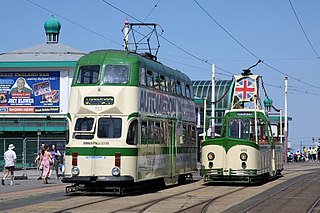
Blackpool Heritage Trams are a mixed fleet of restored vehicles that run on the Blackpool Tramway, which runs from Blackpool to Fleetwood on the Fylde Coast in Lancashire, England. The line dates back to 1885 and is one of the oldest electric tramways in the world. It is operated by Blackpool Transport (BT) and is the last surviving first-generation tramway in the United Kingdom. Excluding museums, it is one of only a few tramways in the world to still use double-decker trams.



















